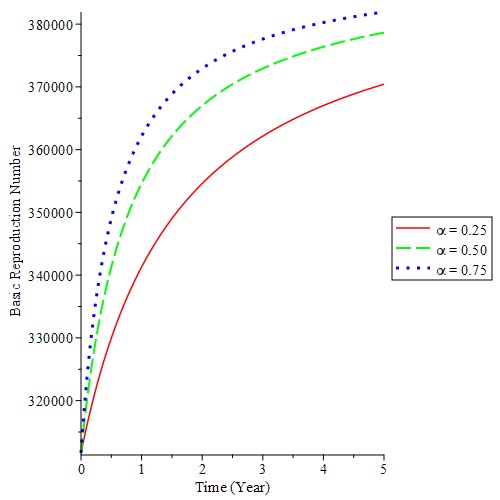Mathematical Model for the Control of Unemployment in Nigeria Incorporating Vocational Education and Apprenticeship
DOI:
https://doi.org/10.23851/mjs.v36i2.1655Keywords:
Unemployment, Vocational education, Apprenticeship, Stability analysis, Sensitivity analysisAbstract
Background: Youth unemployment presents a significant threat to Nigeria’s socioeconomic stability, resulting in widespread issues such as poverty, insecurity, banditry, inequality, and robbery. Objective: In this paper, mathematical modelling for the control of unemployment in Nigeria incorporating vocational education and apprenticeship was formulated. The model equilibrium points were obtained and the local stability analysis was carried out. Methods: The basic reproduction number Re was computed using the Next Generation Matrix technique and used to determine whether unemployment will persist or be eradicated in Nigeria. Sensitivity analysis was carried out to determine the most sensitive parameters. Results: Numerical simulations were presented in a graphical form to show the effects of sensitive parameters on the reproduction number. The stability analysis shows that unemployment will be eradicated in Nigeria if Re ≤ 1. It was revealed from the sensitivity analysis that the theoretical education graduate employment rate, γ is the most sensitive parameter with −0.9883 and the rate of transition of becoming highly skilled due to vocational education, β is the least sensitive parameter with −0.0409. Conclusions: It was shown from the sensitivity analysis and the graphical presentation that the theoretical education graduate employment rate, γ is the most sensitive negative parameter which will decrease the reproduction number. This implies that when employment is created for the graduates from the higher institutions the unemployment rate will reduce drastically from the society. It is recommended that the government and the private sector owners should create more job for the graduates. Optimal control analysis is recommended for future research to determine the minimal cost for the increase graduate employment rate and motivation of vocational education.
Downloads
References
N. Sirghi, M. Neamtu, and D. Deac, "A dynamic model for unemployment control with distributed delay," in Business administration; Mathematical methods in finance and business administration; proceedings of the 8th WSEAS international conference on business administration (ICBA '14), proceedings of the 2nd, vol. 2014, 2014, pp. 42–48.
Google Scholar | Link
National Bureau of Statistics (NBS), "Annual Nigerian labour force survey report," National Bureau of Statistics (NBS), Nigeria, 2023.
Link
International Labour Organization, “World employment and social outlook: Trends 2024,” ILO; Geneva, 2024, p. 113.
CrossRef
A. K. Singh, P. K. Singh, and A. K. Misra, "Combating unemployment through skill development," Nonlinear Analysis: Modelling and Control, vol. 25, no. 6, pp. 919–937, 2020.
CrossRef | Google Scholar
A. K. Misra, A. K. Singh, and P. K. Singh, "Modeling the role of skill development to control unemployment," Differential Equations and Dynamical Systems, vol. 30, no. 2, pp. 397–409, 2017.
CrossRef | Google Scholar
R. Audu, S. Maaji, A. Idris, S. Jido, and I. Shehu, "Entrepreneurship education for alleviating youth unemployment in Nigeria: A case study of technical vocational education and training," pp. 86–99, 2019.
Google Scholar | Link
S. Al-Sheikh, R. Al-Maalwi, and H. A. Ashi, "A mathematical model of unemployment with the effect of limited jobs," Comptes Rendus. Mathématique, vol. 359, no. 3, pp. 283–290, 2021.
CrossRef | Google Scholar
S. B. Munoli and S. Gani, "Optimal control analysis of a mathematical model for unemployment," Optimal Control Applications and Methods, vol. 37, no. 4, pp. 798–806, 2015.
CrossRef | Google Scholar
A. Galindro and D. F. M. Torres, "A simple mathematical model for unemployment: A case study in Portugal with optimal control," Statistics, Optimization & Information Computing, vol. 6, no. 1, 2018.
CrossRef | Google Scholar
L. F. Vesa, "Dynamics of a simple mathematical model for unemployment with time delay," Annals of West University of Timisoara - Mathematics and Computer Science, vol. 58, no. 2, pp. 85–95, 2022.
CrossRef | Google Scholar
L. Harding and M. Neamţu, "A dynamic model of unemployment with migration and delayed policy intervention," Computational Economics, vol. 51, no. 3, pp. 427–462, 2016.
CrossRef | Google Scholar
R. M. Al-Maalwi, H. A. Ashi, and S. Al-sheikh, "Unemployment model," Applied Mathematical Sciences, vol. 12, no. 21, pp. 989–1006, 2018.
CrossRef | Google Scholar
A. Misra, M. Kumari, and M. Sajid, "Role of informal sector to combat unemployment in developing economy: A modeling study," Heliyon, vol. 10, no. 13, p. e33378, 2024.
CrossRef | Google Scholar | PubMed
E. R. Njike‑Tchaptchet and C. Tadmon, "Mathematical modeling of the unemployment problem in a context of financial crisis," Mathematics and Computers in Simulation, vol. 211, pp. 241–262, Sep. 2023.
CrossRef | Google Scholar
M. El Yahyaoui and S. Amine, "Mathematical modeling of unemployment dynamics with skills development and cyclical effects," Partial Differential Equations in Applied Mathematics, vol. 11, p. 100800, Sep. 2024.
CrossRef | Google Scholar
R. Al-Maalwi, S. Al-Sheikh, H. Ashi, and S. Asiri, "Mathematical modeling and parameter estimation of unemployment with the impact of training programs," Mathematics and Computers in Simulation, vol. 182, pp. 705–720, Apr. 2021.
CrossRef | Google Scholar
E. Y. Mohamed, "Stability and control analysis of an unemployment model incorporating integration programs effect," Advanced Mathematical Models & Applications, vol. 9, no. 2, pp. 267–285, 2024.
CrossRef | Google Scholar
A. Ayoade, O. Odetunde, and B. Falodun, "Modeling and analysis of the impact of vocational education on the unemployment rate in Nigeria," Applications and Applied Mathematics: An International Journal (AAM), vol. 15, no. 1, pp. 550–564, 2020.
Google Scholar | Link
H. A. Ashi, R. M. Al-Maalwi, and S. Al-Sheikh, "Study of the unemployment problem by mathematical modeling: Predictions and controls," The Journal of Mathematical Sociology, vol. 46, no. 3, pp. 301–313, 2021.
CrossRef | Google Scholar
E. Kaslik, M. Neamţu, and L. F. Vesa, "Global stability analysis of an unemployment model with distributed delay," Mathematics and Computers in Simulation, vol. 185, pp. 535–546, Jul. 2021.
CrossRef | Google Scholar
S. Somma, R. Balogun, F. Eguda, N. Abdurrahman, P. Adama, and E. Yisa, "Stability analysis of the mathematical modelling of transmission and control of rabies incorporating vaccination class," Dutse Journal of Pure and Applied Sciences, vol. 8, no. 1a, pp. 36–44, 2022.
CrossRef | Google Scholar
S. A. Somma, N. I. Akinwande, P. Gana, O. D. Ogwumu, T. T. Ashezua, and F. Y. Eguda, "Stability and bifurcation analysis of a mathematical modeling of measles incorporating vitamin A supplement," Sule Lamido University Journal of Science and Technology, vol. 2, no. 1, pp. 1–18, 2021.
Google Scholar | Link
N. I. Akinwande, S. A. Somma, R. O. Olayiwola, T. T. Ashezua, R. I. Gweryina, F. A. Oguntolu, O. N. Abdurahman, F. S. Kaduna, T. P. Adajime, F. A. Kuta, S. Abdulrahman, A. I. Enagi, G. A. Bolarin, M. D. Shehu, and A. Usman, "Modelling the impacts of media campaign and double dose vaccination in controlling COVID-19 in Nigeria," Alexandria Engineering Journal, vol. 80, pp. 167–190, Oct. 2023.
CrossRef | Google Scholar
S. A. Somma, N. I. Akinwande, "Sensitivity analysis for the mathematical modelling of monkey pox virus incorporating quarantine and public enlightenment campaign," FULafia Journal of Science and Technology, vol. 6, no. 1, pp. 54–61, 2020.
Google Scholar | Link
N. I. Akinwande, T. T. Ashezua, R. I. Gweryina, S. A. Somma, F. A. Oguntolu, A. Usman, O. N. Abdurrahman, F. S. Kaduna, T. P. Adajime, F. A. Kuta, S. Abdulrahman, R. O. Olayiwola, A. I. Enagi, G. A. Bolarin, and M. D. Shehu, "Mathematical model of COVID-19 transmission dynamics incorporating booster vaccine program and environmental contamination," Heliyon, vol. 8, no. 11, p. e11513, 2022.
CrossRef | Google Scholar | PubMed

Downloads
Additional Files
Key Dates
Received
Revised
Accepted
Published
Data Availability Statement
All data generated or analyzed during this study are included in this published article (and its supplementary material file).
Issue
Section
License
Copyright (c) 2025 Samuel Abu Somma, Rokeeb O. Omotinuwe, Nurat Olamide Abdurrahman

This work is licensed under a Creative Commons Attribution 4.0 International License.
(Starting May 5, 2024) Authors retain copyright and grant the journal right of first publication with the work simultaneously licensed under a Creative Commons Attribution (CC-BY) 4.0 License that allows others to share the work with an acknowledgement of the work’s authorship and initial publication in this journal.





















